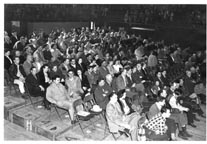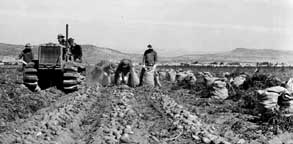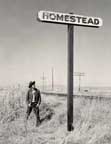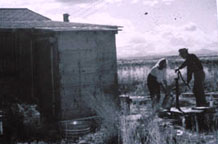Tulelake is a farm community in the Klamath Basin on
the border of California and Oregon. Around the turn
of the century, as America realized the need for
prime farmland, settlers came from all around the
country to raise livestock and grow their crops.
People even came from as far away as Czechoslovakia.
It was truly a pioneer’s dream.
This is some of the
most fertile soil in America because of the
volcanically enriched deposits found in the lake
beds and also the high organic matter. Tule Lake and
Lower Klamath Lake were huge lakes in a closed
basin, and water flowed back and forth between
Klamath Lake and the basin. During wet seasons,
water spread across the land, and when water was
low, it receded back into the lake.
The only natural
outlet to Upper Klamath Lake, Link River,
occasionally went dry. The river flows into Lake
Ewauna and is the actual headwaters to the Klamath
River. Farming and ranching requires a reliable
source of water. When the Reclamation Irrigation
Project was built in the early 1900’s, water was
rerouted into reservoirs and Klamath Lake to be
stored for irrigation. Diversion channels were dug
so the excess water could be sent down Klamath
River. This was water that seldom before had ever
left the closed basin. Our parents, grandparents and
neighbors paid for the entire Klamath Project.
|

WWII Veterans during
the land
lottery for Tule Lake property 1947 |

potato harvest a
long time ago |

Bill Macy 1947 |
Many of the
settlers were World War I and WWII homesteaders who
were offered participation in a lottery drawing as
an honor for their service in defending our country.
These young people, mostly in their early 20’s,
depended on each other. From nothing but a lake bed,
with no roads, electricity, or infrastructure, they
built this community, and it took camaraderie and
working together to make it work.
Along with hundreds
of settlers came an entire community and economy,
which was totally supported by the agricultural and
logging businesses. There were stores for clothes,
shoes, tires, livestock supplies, feed stores, cars
and trucks and tractors.
My parents came to
Tulelake in 1949 in a 1947 Dodge Truck. Dad had just
gotten out of the service in WWII and his name was
drawn out of the pickle jar to win an 80-acre
homestead in Tulelake. Some other newcomers bought
their farms and ranches.
Most of us
irrigators are second, third and fourth generation
farmers. We grew up on horses, driving old grain
trucks, and riding one-speed bicycles. The ditch
banks and fields were our playground. The beloved
community was, and is, our extended family.
We were taught
important values and because we shouldered huge
responsibilities, were given all the freedom in the
world. Imagine being trusted to drive a tractor or
be gone all day long on your horse while still in
grade school! We loved our neighbors because, while
someone’s dad doctored our sheep, our own father
wired their houses. We exemplified the best of what
an American community is built on; where everyone
lends a hand, everyone participates, everyone
contributes. We knew that we belonged, that we were
each an important thread in the tapestry of our
community.
Everyone in Rural
America has a place. There are animals to feed, cows
to milk, grain to plant. So each person has a place
of importance, and each person is responsible for
his home, his community and his country. We had to
build our own community; unlike so many modern day
families who simply move into a new town where
everything they need is already in place.
Our area is a
wildlife paradise. Geese at times blacken the skies,
deer, antelope, coyotes, ducks, hawks and eagles
live in our fields and ditches. The frogs and
crickets sing to us all night. That is one of the
reasons our families were drawn to the Klamath
Basin; a rich landscape in which to spend the rest
of our lives. All 433 species living here depend on
water.
Since there were
between 20 - 40 feet of water on our property in
Tule Lake before the Project was built, our deed
includes the guarantee of 2 1/2 acre feet of water
per acre for the rest of our lives and our heir's
thereafter. As this excess water was diverted to
Klamath Lake for irrigation storage and more excess
into Klamath River, we were promised a low power
rate since our excess water created power. It was a
business transaction and a good way to feed the
hungry nation. Americans understood the need to be
self-sufficient.
In 2001 the Bureau
of Reclamation shut off water to the entire Klamath
Project because of a biological ‘opinion’ regarding
‘endangered’ sucker fish that later was found to be
"unjustified" by the National Academy of Science.
Our elderly settlers were devastated. Faith in their
government, for the first time ever, was shaken, and
dreams and pride were shattered. They were being
treated like enemies, and their property deeds,
signed by their President of the United States, were
without value.
The settlers wanted
to put together a documentary about their lives.
Here is their amazing story.
Quotes about the
video:
"It was absolutely
superb! You captured not only the essence of the
basin, but of rural America."
Jeffrey Stoffer, managing editor for American Legion
Magazine.
"It shows the wide range of emotions felt by the
Tulelake homesteaders in the past century, from the
joy and hope felt when World War I veterans began to
build a future from scratch, to the pain and sense
of betrayal felt when the U.S. government took their
water away in 2001." Dan Keppen, executive
director Klamath Water Users Association:
"This should be seen on PBS!" Doris Bowen,
area resident, former superintendent at the Lava
Beds National Monument.
"This video tells a
compelling story about people, and the communities
they built. This, not the headlines and misguided
accusations, is the reality of the Klamath Project.
Paul Simmons, KWUA attorney.
"Great film. It
gave me much more perspective that I originally
had." Leslie Lowe, Klamath Audubon Society
member.
"You have captured
the essence of our souls".
Wilma Heiney, 2nd generation Tulelake farm family.
This 60-minute
video shows magnificent landscape, wildlife, a year
of seasons and farming, along with historic and
family photos. Several settlers tell this 100-year
story. Over 80 Tulelakers participated in this
project and 16 local businesses sponsored it.
Photographer and filmmaker Anders Tomlinson, and
Jacqui Newkirk Krizo, Tulelake homesteader's
daughter, made this documentary. Lars Larson,
Portland radio KXL talk show host, and locals Bill
Quinn and Mildred Tofell, narrate the film.
Now on sale
VHS videos:$20.00 each (plus $1.45 sales tax for
California Residents only)
DVD: $25.00 each (plus $1.81 sales tax for
California residents only)
3.00 shipping and handling
Make check payable to
Homestead Video
P.O. Box 314
Tulelake, CA 96134
All proceeds help
support the
www.klamathbasincrisis.org website, the
"voice of the
irrigators and their community."
|






